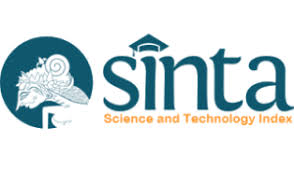ANALISIS KAUSALITAS INFRASTRUKTUR TRANSPORTASI TERHADAP PERTUMBUHAN EKONOMI DI INDONESIA
 Abstract views: 496
,
Abstract views: 496
,
 pdf (Bahasa Indonesia) downloads: 985
pdf (Bahasa Indonesia) downloads: 985
Abstract
This research aims to analyze the causality between transportation infrastructure and economic growth in Indonesia using Vector Error Correction Model (VECM) with data from 1990-2020. The results show that there is a two-way causality between road and air transportation infrastructure and economic growth. Additionally, there is also a two-way causality between economic growth and gross fixed capital formation with road and air transportation infrastructure. The findings indicate that road transportation infrastructure, air transportation, and gross fixed capital formation have a significant influence on economic growth in both the short and long term. Furthermore, air transportation infrastructure, road transportation infrastructure, and economic growth also have a significant influence on gross fixed capital formation in both the short and long term. This research also found that economic growth and gross fixed capital formation have a significant influence on road and air transportation infrastructure. Therefore, these results can provide input for the government in determining transportation infrastructure development policies that can support economic growth and gross fixed capital formation in Indonesia.
References
Alam, K. M., Li, X., Baig, S., Ghanem, O., & Hanif, S. (2021). Causality between transportation infrastructure and economic development in Pakistan: An ARDL analysis. Research in Transportation Economics, 88. https://doi.org/10.1016/j.retrec.2020.100974
Ardiansyah, H. (2017). Pengaruh Inflasi Terhadap Pertumbuhan Ekonomi di Indonesia. Jurnal Pendidikan Ekonomi.
Aschauer, D. A. (1989). IS PUBLIC EXPENDITURE PRODUCTIVE?*. In Journal of Monetary Economics (Vol. 23).
Badalyan, G., Herzfeld, T., & Rajcaniova, M. (2014). Transport Infrastructure and Economic Growth: Panel Data Approach for Armenia, Georgia and Turkey.
Badan Pusat Statistik. (2015). Produk Domestik Bruto Indonesia Triwulanan Related papers Indikator Ekonomi Provinsi Banten.
Du, X., Zhang, H., & Han, Y. (2022). How Does New Infrastructure Investment Affect Economic Growth Quality? Empirical Evidence from China. Sustainability (Switzerland), 14(6). https://doi.org/10.3390/su14063511
Edquist, C. (2006). SYSTEMS OF INNOVATION (Vol. 1). Routledge.
Hong, J., Chu, Z., & Wang, Q. (2011). Transport infrastructure and regional economic growth: Evidence from China. Transportation, 38(5), 737–752. https://doi.org/10.1007/s11116-011-9349-6
Kamaluddin, R. (2003). Ekonomi Transportasi. Ghalia Indonesia.
Kartiasih, F. (2019). DAMPAK INFRASTRUKTUR TRANSPORTASI TERHADAP PERTUMBUHAN EKONOMI DI INDONESIA MENGGUNAKAN REGRESI DATA PANEL. Jurnal Ilmiah Ekonomi Dan Bisnis, 16(1).
Kodoatie, R. J. (2003). Manajemen dan Rekayasa Infrastruktur. Pustaka Pelajar.
Mankiw, N. G. (2003). Macroeconomics. Worth Publishers.
Maqin, A. (2011). Pengaruh Kondisi Infrastruktur terhadap Pertumbuhan Ekonomi di Jawa Barat (Vol. 10, Issue 1).
Morten, M., & Oliveira, J. (2016). Paving the Way to Development: Costly Migration and Labor Market Integration. http://www.nber.org/papers/w22158
Pradhan, R. P., & Bagchi, T. P. (2013). Effect of transportation infrastructure on economic growth in India: The VECM approach. Research in Transportation Economics, 38(1), 139–148. https://doi.org/10.1016/j.retrec.2012.05.008
Reddy, N. (2018). Economic Infrastructure-Intro, Types, Significance. Toppr Bytes. toppr.com
Siregar, M. (2012). Beberapa Masalah Ekonomi dan Manajemen Transportasi. Universitas Indonesia.
Sukirno, S. (2009). Teori Pengantar: Mikroekonomi.
Tamin, O. Z. (2000). Perencanaan dan Permodelan Transportasi. Institut teknologi Bandung.
Vagliasindi, M. (2022, April 18). How Does Infrastructure Support Sustainable Growth. World Bank Blogs. blogs.worldbank.org
Wicaksono, B., Triwahyuningtyas, N., Shinta Aminda, R., Pembangunan Nasional Veteran Jakarta, U., & Jakarta, D. (n.d.). ANALISIS PENGARUH JUMLAH TRANSPORTASI DARAT, INFRASTRUKTUR DAN JUMLAH PENDUDUK TERHADAP PRODUK DOMESTIK BRUTO (PDB) INDONESIA. 5(3), 2021.
Wijaya, W. D. (2016). Perencanaan Penanganan Kawasan Pemukiman Kumuh Studi Penentuan Kawasam Prioritas untuk Peningkatan Kualitas Infrastruktur pada Kawasan Pemukiman Kumuh di Kota Malang. Jurnal Ilmiah Administrasi Publik, 2(1), 1–10.
Wooldridge, M. J. (2013). Introductory Econometrics: A Modern Approach (Fifth Edition). South-Western, Cengage Learning.
Yu, N., de Jong, M., Storm, S., & Mi, J. (2012). Transport Infrastructure, Spatial Clusters and Regional Economic Growth in China. In Transport Reviews (Vol. 32, Issue 1, pp. 3–28). https://doi.org/10.1080/01441647.2011.603104
CC BY 4.0 Creative Commons Attribution 4.0 International. This license requires that reusers give credit to the creator. It allows reusers to distribute, remix, adapt, and build upon the material in any medium or format, even for commercial purposes.
BY: Credit must be given to you, the creator.


2.png)






